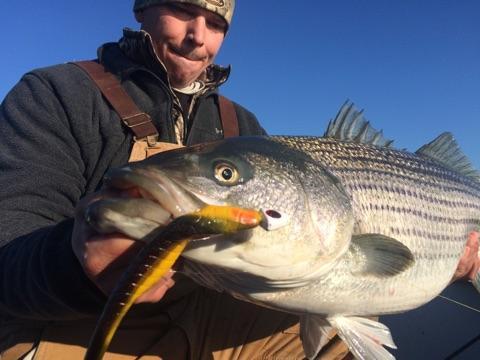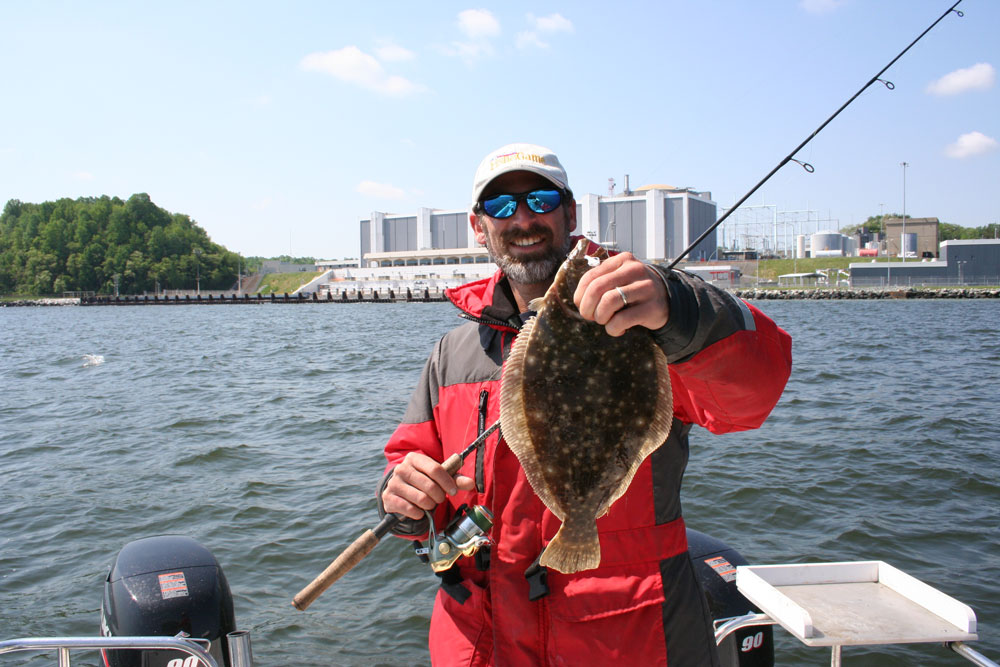The warm water discharge at Calvert Cliffs Nuclear Power Plant (CCNPP) gushes a whitewater torrent into the middle Chesapeake Bay, yet the discharge at Brandon Shores meanders gently into the mouth of the Patapsco. The warm water flow at Baltimore’s MedStar Hospital, meanwhile, is barely perceptible. Yet all of these locations often hold fish when the surrounding waters are barren, and sometimes they provide world-class fisheries. Before we dig into the details, join us for a trip to the CCNPP discharge in mid-March, just prior to Maryland trophy striped bass season in 2017. (Editor's note: it is now illegal to target striped bass during certain portions of the spring and these regs are constantly changing. See the latest Maryland Chesapeake Bay regulations for current info.
WARM WATER FISHING TACTICS
As you saw in the video, the tactics used to catch these striped bass are pretty specific: snap-jigging soft plastics just off the bottom, right in the flow of warm water. This is more or less effective across the board at any warm water discharge where rockfish will be found, although in areas with less current, you won’t need as much weight nor as aggressive a jigging motion.
Anglers also find success by drifting right through the moving water, and jigging vertically. But this tactic may comes at a price—it can spook the fish, and shut down the bite. Stripers can be a lot spookier than some folks believe, and often turn off when loud or sharp noises project violent vibrations through the water. People are often surprised, however, to learn just how these vibrations are created. Many assume that the noise of an idling outboard engine, for example, is the culprit. And in the case of a two-stroke outboard, they may well be correct. A two-stroke creates quite a racket. But the majority of today’s outboards are four-strokes, and if you drop a hydrophone below the water’s surface and listen to these different engines, you’ll note quite a difference. While the two-stroke bangs and clangs, a four-stroke is virtually silent.
If that four-stroke is so hushed, what spooks these fish? The answer can be found by leaving that hydrophone in the water, and listening for an extended period of time. You’ll discover that fiberglass impacting fiberglass, like a boat hatch slamming shut, makes a gunshot-like crack that could spook any fish within casting distance. The same is true for hard objects (like lead weights or a metal pair of pliers) dropped onto a fiberglass deck. But perhaps most startling is the amount of noise the human voice makes under water. Yes, the vibrations created by your vocal chords travel right through the H2O. They sound muted (more or less like the “wah-wah-wah” made by adults in those old Peanuts cartoons) but they’re quite loud, and someone yelling “I got a bite!” travels right through the water like a lightning bolt.
Now ask yourself: can you hear someone yelling over the noise of an idling four-stroke outboard? Of course you can. So, doesn’t it make sense that the fish can, too? Some time with a hydrophone will prove the point. The bottom line is that you and everyone else fishing a warm water discharge will catch more fish if everyone takes pains to stay as far as possible from the fish, and make as little noise as possible while fishing.
What about other tactics? Won’t live-lining spot do the trick, for example? Perhaps. But talk to any seasoned striper angler who specializes in fishing a warm water discharge for striped bass, and you’ll find they’re almost always snapping, crawling, or bouncing soft plastics right off the bottom.

SCORE WITH THE LURE
As you saw in the video, plastics like BKDs or Bust ‘em Baits, will do the trick. But size matters. Those in search of trophy rockfish will toss 10 inch baits, while those who want the maximum number of bites will use seven or six inch lures. Smaller lures will result in more hook-ups, but usually with smaller fish. If you want a monster stick with the big baits.
Color counts, too. Fortunately, however, there are no big surprises in this regard and the usual lure color choice “rules” apply. (Note: there are no rules when it comes to fishing!) Match your lure color to the water color at the start, and vary your choice as the results dictate. In green water, begin by casting chartreuse. In clear water, white is likely the best starting point. In low-light conditions try darks like purple and black. And no matter what the conditions may be, remember that contrast in a lure is always a good thing.
Beyond lure selection, the gear you choose to use is really just a matter of personal preference. Spinning or conventional gear works just fine, so long as you have a rod with a fairly fast action and enough sensitivity to feel when your lure touches bottom. Line choice, however, isn’t quite as forgiving. Braid is a must, especially when fishing in discharges with a strong current, because the resulting bow in the line makes it extremely difficult to figure out when your lure hits bottom and even when a fish strikes. Add the stretching characteristics of monofilament to that bow, and extremely difficult becomes virtually impossible.
THE FISHING NEVER ENDS
While fishing at warm water discharges is normally thought of as an off-season event, the fact of the matter is that many discharges hold fish at all or most times of the year — even mid-summer, in many cases. This may be due to the unusual currents they create, the differing temperatures, or the physical structure (like pipes and rockpiles) that accompany them. Don’t ignore these spots simply because it’s warm out. Once again, the CCNPP provides a great example. During the middle of the summer, fishing for both stripers and flounder is often quite good here — but not necessarily right in the discharge. The surrounding areas regularly hold more fish than the moving water, even though the opposite is true during the winter months.

The down-side to fishing these spots is that they’re quite limited in size. At all of the warm water discharges you need to be prepared to deal with a lot of competition on nice days, especially on weekends. You may need to wait your turn, to move into a prime position among a crowd of drifting boats. And quite regularly, a boat with loud anglers onboard may affect your success. But the promise these spots hold greatly out-weighs the negatives. Make a few trips to a warm water discharge and play your cards right, and sooner or later you’re likely to tie into a trophy-sized striper on light tackle. And that should be attraction enough for any Mid-Atlantic angler.
Editor's note: This article was published in April of 2017 and was last updated May 7, 2024.